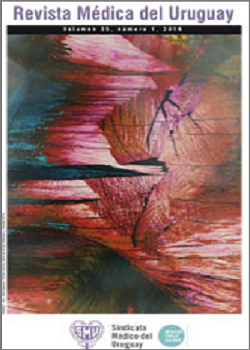Analysis of diagnostic laparoscopy and imaging studies for the handling of pain in undetermined etiology right iliac fossa
Abstract
Introduction:
right iliac fossa (RIF) pain is a frequent reason for consultation at the Emergency Units. The main challenge lies in defining whether it is a surgical condition or not.
Objective:
to learn about the role of diagnostic laparoscopy, abdominal ultrasound and CT scan in the studies algorithm of patients with RIF pain of unknown etiology in Uruguay.
Method:
observational, descriptive, prospective, multi-center study of patients who consulted for RIF from June 1st to August 31, 2017 in Health Institutions in Uruguay. The following data were gathered in an excel sheet: sex, age, symptoms, physical findings, tests requested, conduct adopted, intraoperative findings and complications.
Results:
159 sheets were completed. Upon a primary assessment a diagnostic doubt was arose in 69 patients (43.4%). A CT scan was requested to 29 patients, and a CT was performed to 78% of patients older than 50 years old vs 18% of those between 15 and 29 years.
Conclusions:
the diagnostic laparoscopy allowed for diagnosis in most cases. Sensitivity of the CT scan was low when compared to international data. The diagnostic algorithm needs to me individualized, based on protocols adapted to the resources of every institution.
References
(1) Hori Y; SAGES Guidelines Committee. Diagnostic laparoscopy guidelines: this guideline was prepared by the SAGES Guidelines Committee and reviewed and approved by the Board of Governors of the Society of American Gastrointestinal and Endoscopic Surgeons (SAGES), November 2007. Surg Endosc 2008; 22(5):1353-83.
(2) Agresta F, Ansaloni L, Baiocchi GL, Bergamini C, Campanile FC, Carlucci M, et al. Laparoscopic approach to acute abdomen from the Consensus Development Conference of the Società Italiana di Chirurgia Endoscopica e nuove tecnologie (SICE), Associazione Chirurghi Ospedalieri Italiani (ACOI), Società Italiana di Chirurgia (SIC), Società Italiana di Chirurgia d’Urgenza e del Trauma (SICUT), Società Italiana di Chirurgia nell’Ospedalità Privata (SICOP), and the European Association for Endoscopic Surgery (EAES). Surg Endosc 2012; 26(8):2134-64.
(3) Wray CJ, Kao LS, Millas SG, Tsao K, Ko TC. Acute appendicitis: controversies in diagnosis and management. Curr Probl Surg 2013; 50(2):54-86.
(4) Doria AS, Moineddin R, Kellenberger CJ, Epelman M, Beyene J, Schuh S, et al. US or CT for Diagnosis of appendicitis in children and adults?: a Meta-Analysis. Radiology 2006; 241(1):83-94.
(5) Lee CC, Golub R, Singer AJ, Cantu R Jr, Levinson H. Routine versus selective abdominal computed tomography scan in the evaluation of right lower quadrant pain: a randomized controlled trial. Acad Emerg Med 2007; 14(2):117-22.
(6) Krajewski S, Brown J, Phang PT, Raval M, Brown CJ. Impact of computed tomography of the abdomen on clinical outcomes in patients with acute right lower quadrant pain: a meta-analysis. Can J Surg 2011; 54(1):43-53.
(7) Gammeri E, Catton A, van Duren BH, Appleton SG, van Boxel GI. Towards an evidence-based management of right iliac fossa pain in the over 50-year-old patient. Ann R Coll Surg Engl 2016; 98(7):496-9.
(8) Howlett DC, Drinkwater K, Frost C, Higginson A, Ball C, Maskell G. The accuracy of interpretation of emergency abdominal CT in adult patients who present with non-traumatic abdominal pain: results of a UK national audit. Clin Radiol 2017; 72(1):41-51.
(9) Cuschieri J, Florence M, Flum DR, Jurkovich GJ, Lin P, Steele SR, et al. Negative appendectomy and imaging accuracy in the Washington State Surgical Care and Outcomes Assessment Program. Ann Surg 2008; 248(4):557-63.
(10) Agresta F, Campanile FC, Podda M, Cillara N, Pernazza G, Giaccaglia V, et al. Current status of laparoscopy for acute abdomen in Italy: a critical appraisal of 2012 clinical guidelines from two consecutive nationwide surveys with analysis of 271,323 cases over 5 years. Surg Endosc 2017; 31(4):1785-95.
(11) McCartan DP, Fleming FJ, Hill AD. Patient and surgeon factors are associated with the use of laparoscopy in appendicitis. Colorectal Dis 2012; 14(2):243-9.
(12) Golash V, Willson PD. Early laparoscopy as a routine procedure in the management of acute abdominal pain: a review of 1,320 patients. Surg Endosc 2005; 19(7):882-5.
(13) Maggio AQ, Reece-Smith AM, Tang TY, Sadat U, Walsh SR. Early laparoscopy versus active observation in acute abdominal pain: systematic review and meta-analysis. Int J Surg 2008; 6(5):400-3.
(14) Domínguez LC, Sanabria A, Vega V, Osorio C. Early laparoscopy for the evaluation of nonspecific abdominal pain: a critical appraisal of the evidence. Surg Endosc 2011; 25(1):10-8.
(15) Moberg AC, Ahlberg G, Leijonmarck CE, Montgomery A, Reiertsen O, Rosseland AR, et al. Diagnostic laparoscopy in 1043 patients with suspected acute appendicitis. Eur J Surg 1998; 164(11):833-40
(16) Lee M, Paavana T, Mazari F, Wilson TR. The morbidity of negative appendicectomy. Ann R Coll Surg Engl 2014; 96(7):517-20.
(17) Garbarino S, Shimi SM. Routine diagnostic laparoscopy reduces the rate of unnecessary appendicectomies in young women. Surg Endosc 2009; 23(3):527-33.
(18) Gaitán HG, Reveiz L, Farquhar C, Elias VM. Laparoscopy for the management of acute lower abdominal pain in women of childbearing age. Cochrane Database Syst Rev 2014;(5):CD007683.
(19) Jones GE, Kreckler S, Shah A, Stechman MJ, Handa A. Increased use of laparoscopy in acute right iliac fossa pain - is it good for patients? Colorectal Dis 2012; 14(2):237-42.
(20) McGreevy JM, Finlayson SR, Alvarado R, Laycock WS, Birkmeyer CM, Birkmeyer JD. Laparoscopy may be lowering the threshold to operate on patients with suspected appendicitis. Surg Endosc 2002; 16(7):1046-9.













